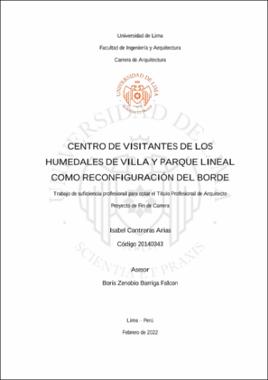Mostrar el registro sencillo del ítem
Centro de visitantes de los humedales de Villa y parque lineal como reconfiguración del borde
| dc.contributor.advisor | Barriga Falcón, Boris Zenobio | |
| dc.contributor.author | Contreras Arias, Isabel | |
| dc.date.accessioned | 2022-04-20T18:59:39Z | |
| dc.date.available | 2022-04-20T18:59:39Z | |
| dc.date.issued | 2022 | |
| dc.identifier.citation | Contreras Arias, I. (2022) Centro de visitantes de los humedales de Villa y parque lineal como reconfiguración del borde [Trabajo de suficiencia profesional para optar el Título Profesional de Arquitecto, Universidad de Lima]. Repositorio Institucional de la Universidad de Lima. https://hdl.handle.net/20.500.12724/15629 | es_PE |
| dc.identifier.uri | https://hdl.handle.net/20.500.12724/15629 | |
| dc.description.abstract | Los humedales son uno de los ecosistemas más trascendentales y significativos que hay en el mundo para el desarrollo sostenible, por los beneficios ecosistémicos, económicos y culturales que brindan. Sin embargo, con frecuencia se subestima la relevancia de los mismos. Los Pantanos de Villa son un tipo de humedal que forma parte del Corredor Biológico de la Costa Central del Perú y forma parte fundamental de la infraestructura ecológica de la ciudad de Lima. Pues es la única área natural protegida ubicada en Lima metropolitana y reconocida internacionalmente por el Convenio Ramsar. Lamentablemente, al igual que la tendencia global, el humedal se ha reducido y degradado en un 83% en los últimos 75 años. La investigación presente tiene la finalidad de identificar las variables problemáticas de este escenario y proponer una respuesta mediante la reconfiguración el borde del área natural, como forma de proteger la biodiversidad y dotar de espacios de calidad a los ciudadanos la zona. A partir de esta premisa se plantea el proyecto de centro de visitantes y parque lineal que propone un enfoque sistémico de espacios que configuren un nuevo borde para el humedal, tomando en cuenta características intrínsecas del lugar desde su origen, la naturaleza de su funcionamiento, los ecosistemas y biodiversidad, la composición urbana en el borde y la evolución de estos factores a lo largo de su existencia. La idea es que finalmente se aporte a la ciudad con la regeneración de un ecosistema importante, con infraestructura turística y cultural de calidad, establecer un precedente para proyectos similares en el futuro y con la mejora general en la calidad de vida de población inmediata. | es_PE |
| dc.description.abstract | Wetlands are one of the most important and critical ecosystems in the world for sustainable development, due to the ecosistemic, economic and cultural benefits they provide. However, their relevance is often underestimated. Pantanos de Villa are a type of wetland that is part of the “Biological Corridor of the Central Coast of Peru” and is a fundamental part of the ecological infrastructure of the city of Lima. It is the only protected natural area located in metropolitan Lima and internationally recognized by the Ramsar Convention. Unfortunately, similar to the global trend, this wetland has continued to reduce and deteriorate its surface in quantity and quality by 83% in the last 75 years. The present research aims to reconfigure the edge of the natural area of the Villa wetlands, protect biodiversity and provide quality spaces to the citizens of the area. Based on this premise, it is proposed the development of the Visitor Center and Linear Park of Villa, which proposes a systemic approach to spaces that configure a new edge for the wetland, taking into account intrinsic characteristics of the place from its origin, the nature of its operation, the ecosystems and biodiversity, the urban composition on the edge and the evolution of these factors throughout their existence. The idea is that it finally contributes to the city with the regeneration of an important ecosystem, with quality tourist and cultural infrastructure, setting a precedent for similar projects in the future and with the overall improvement in the quality of life of the immediate population. | en_EN |
| dc.format | application/pdf | |
| dc.language.iso | spa | |
| dc.publisher | Universidad de Lima | |
| dc.rights | info:eu-repo/semantics/openAccess | * |
| dc.rights.uri | https://creativecommons.org/licenses/by-nc-sa/4.0/ | * |
| dc.source | Repositorio Institucional - Ulima | |
| dc.source | Universidad de Lima | |
| dc.subject | Landscape architecture | en_EN |
| dc.subject | Public spaces | en_EN |
| dc.subject | Urbanism | en_EN |
| dc.subject | Arquitectura del paisaje | es_PE |
| dc.subject | Espacios públicos | es_PE |
| dc.subject | Urbanismo | es_PE |
| dc.subject | Humedales | es_PE |
| dc.subject | Zona reservada de los Pantanos de Villa (Lima, Perú) | es_PE |
| dc.subject | Wetlands | es_PE |
| dc.title | Centro de visitantes de los humedales de Villa y parque lineal como reconfiguración del borde | es_PE |
| dc.title.alternative | Visitor center of the Villa wetland and linear park as reconfiguration of its edges | en_EN |
| dc.type | info:eu-repo/semantics/bachelorThesis | |
| thesis.degree.level | Título Profesional | es_PE |
| thesis.degree.discipline | Arquitectura | es_PE |
| thesis.degree.grantor | Universidad de Lima. Facultad de Ingeniería y Arquitectura | es_PE |
| dc.publisher.country | PE | |
| dc.type.other | Trabajo de suficiencia profesional | |
| thesis.degree.name | Arquitecto | es_PE |
| renati.advisor.orcid | https://orcid.org/0000-0002-2291-1791 | |
| renati.discipline | 731026 | |
| dc.identifier.isni | 121541816 | |
| renati.author.dni | 71727234 | |
| renati.level | https://purl.org/pe-repo/renati/level#tituloProfesional | * |
| renati.advisor.dni | 41817431 | |
| renati.juror | Zadel Velásquez, Vanessa Luciana | |
| renati.juror | Díaz Mora, Pablo Inty | |
| renati.juror | Rozas Schmitt, Patricia | |
| renati.type | https://purl.org/pe-repo/renati/type#trabajoDeSuficienciaProfesional | * |
| dc.subject.ocde | https://purl.org/pe-repo/ocde/ford#6.04.08 | |
| ulima.cat | OI |



